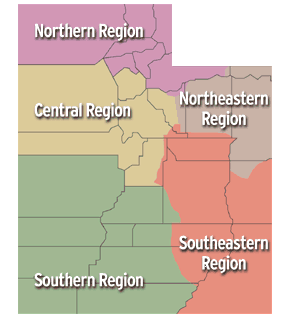
ST. GEORGE — If you or someone you know may be of service in deciding how hunting, fishing and wildlife are managed in Utah, positions are opening up on Utah’s wildlife regional advisory councils and on the Utah Wildlife Board.

The advisory councils help decide how wildlife is managed in Utah. The councils listen to proposals from the Division of Wildlife Resources and take input from the public about those proposals. They then vote and submit their recommendations to the Wildlife Board, which has the final say in wildlife management decisions.
Applications and nominations for the open positions may be submitted to the DWR starting Wednesday and must be received by 5 p.m. March 15.
The state is divided into five wildlife regions: northern, northeastern, central, southern and southeastern. See region map attached to this report.
Wildlife Regional Advisory Council
Advisory council positions are opening in all five regions.
Councils meet about six times a year with meetings lasting from three to five hours. Meetings are held in the evenings, usually on a Tuesday, Wednesday or Thursday.
Council members represent one of six interests: hunters, anglers and trappers; those who don’t hunt or fish; ranchers and farmers; locally-elected public officials; federal land managing agencies; and the public-at-large.
Except for federal land managing agency positions, which are appointed by the agencies, all positions require the nominee live in the region he or she would represent.
If you want to represent the public-at-large, you must contact a group in your community and ask them to nominate you. Political groups, town councils, animal sanctuary committees and recreational groups are examples of groups that have nominated people in the past.
If you want to fill one of the other positions, you must contact a conservation group or organization in your region and ask that they nominate you to serve in the vacancy you’d like to fill. For example, if you want to fill a sportsman’s vacancy, you must contact a Utah sportsman’s group and ask them to nominate you for the vacancy.
Download RAC nomination forms RAC webpage or obtain them from any DWR office.

Utah Wildlife Board
Two positions will become available on the Utah Wildlife Board in August when members John Bair and Mike King leave the board after six years of service.
A person needs to have a strong interest in wildlife and wildlife management in Utah to serve on the board, DWR board coordinator Staci Coons said. They also need to be committed to serving and representing the people of the state.
Board members serve a six-year term and generally attend six to seven board meetings in Salt Lake City each year.
“They’re also encouraged to attend monthly Wildlife Regional Advisory Council meetings in their regions,” Coons said. “Some overnight travel is also required.”
The Wildlife Board Nominating Committee — an 11-member committee appointed by the governor — will review applications and select candidates to interview. It will then forward its recommendations to the governor who will make the appointments with consent of the Senate.
The board consists of seven citizens from different parts of the state. State law requires at least one representative on the board for each of the five regions but no more than two for any one region; meaning, two regions will have two representatives.
First seat may be filled by someone from any region except the southern region. Bair is one of two members representing the central region. His vacancy may be filled from any region except the southern region as it already has the maximum representation.
Second seat must be filled by someone from the southeastern region. King is the only board member representing the southeastern region, so his vacancy must be filled by someone in that region to maintain its representation.
Apply online here.
Email: [email protected]
Twitter: @STGnews